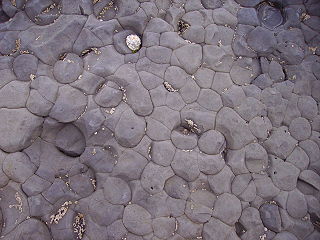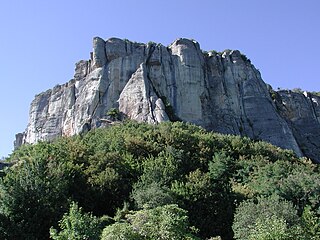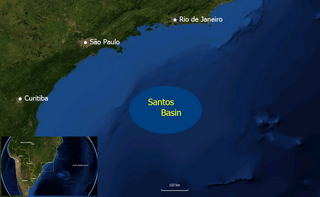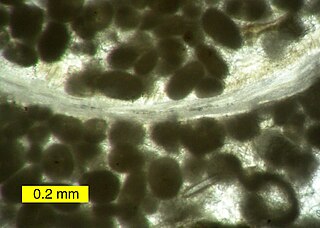Related Research Articles

Sandstone is a clastic sedimentary rock composed mainly of sand-sized silicate grains, cemented together by another mineral. Sandstones comprise about 20–25% of all sedimentary rocks.

Sedimentary rocks are types of rock that are formed by the accumulation or deposition of mineral or organic particles at Earth's surface, followed by cementation. Sedimentation is the collective name for processes that cause these particles to settle in place. The particles that form a sedimentary rock are called sediment, and may be composed of geological detritus (minerals) or biological detritus. The geological detritus originated from weathering and erosion of existing rocks, or from the solidification of molten lava blobs erupted by volcanoes. The geological detritus is transported to the place of deposition by water, wind, ice or mass movement, which are called agents of denudation. Biological detritus was formed by bodies and parts of dead aquatic organisms, as well as their fecal mass, suspended in water and slowly piling up on the floor of water bodies. Sedimentation may also occur as dissolved minerals precipitate from water solution.

Mudstone, a type of mudrock, is a fine-grained sedimentary rock whose original constituents were clays or muds. Mudstone is distinguished from shale by its lack of fissility.

Mudrocks are a class of fine-grained siliciclastic sedimentary rocks. The varying types of mudrocks include siltstone, claystone, mudstone and shale. Most of the particles of which the stone is composed are less than 1⁄16 mm and are too small to study readily in the field. At first sight, the rock types appear quite similar; however, there are important differences in composition and nomenclature.

Allochem is a term introduced by Folk to describe the recognisable "grains" in carbonate rocks. Any fragment from around 0.5 mm upwards in size may be considered an allochem. Examples would include ooids, peloids, oncolites, pellets, fossil or pre-existing carbonate fragments. Fragments are still termed allochems if they have undergone chemical transformations – for example if an aragonite shell were to dissolve and be later replaced by calcite, the replacement would still be deemed an allochem.

Clastic rocks are composed of fragments, or clasts, of pre-existing minerals and rock. A clast is a fragment of geological detritus, chunks, and smaller grains of rock broken off other rocks by physical weathering. Geologists use the term clastic to refer to sedimentary rocks and particles in sediment transport, whether in suspension or as bed load, and in sediment deposits.

Calcarenite is a type of limestone that is composed predominantly, more than 50 percent, of detrital (transported) sand-size, carbonate grains. The grains consist of sand-size grains of either corals, shells, ooids, intraclasts, pellets, fragments of older limestones and dolomites, other carbonate grains, or some combination of these. Calcarenite is the carbonate equivalent of a sandstone. The term calcarenite was originally proposed in 1903 by Grabau as a part of his calcilutite, calcarenite and calcirudite carbonate classification system based upon the size of the detrital grains composing a limestone. Calcarenites can accumulate in a wide variety of marine and non-marine environments. They can consist of grains of carbonate that have accumulated either as coastal sand dunes (eolianites), beaches, offshore bars and shoals, turbidites, or other depositional settings.

Under the Dunham classification system of limestones, a wackestone is defined as a mud-supported carbonate rock that contains greater than 10% grains. Most recently, this definition has been clarified as a carbonate-dominated rock in which the carbonate mud component supports a fabric comprising 10% or more very fine-sand grade or larger grains but where less than 10% of the rock is formed of grains larger than sand grade .
Lutite is old terminology, which is not widely used, by Earth scientists in field descriptions for fine-grained, sedimentary rocks, which are composed of silt-size sediment, clay-size sediment, or a mixture of both. When mixed with water lutites often disintegrate into mud. Because this is a field term, there is a lack of any precise definition for it based upon specific grain-size characteristics. Lutites include a variety of fine-grained sedimentary rocks, including calcisiltite, calcilutite, claystone, mudstone, shale, and siltstone. It is equivalent to the term mudstone and the Greek-derived term pelite. Lutite was first used in 1904 by Grabau, who derived it from lutum, the Latin word for mud. He also proposed a number of prefixes to be used with and attached to "lutite" in order to designate various types of lutites. None of these prefixes are used by Earth scientists nowadays.
Rudite is a general name used for a sedimentary rock composed of rounded or angular detrital grains, i.e. granules, pebbles, cobbles, and boulders, which are coarser than sand in size. Rudites include sedimentary rocks composed of both siliciclastic, i.e. conglomerate and breccia, and carbonate grains, i.e. calcirudite and rudstone. This term is equivalent to the Greek-derived term, psephite. Rudite was initially proposed by Grabau as "rudyte". It is derived from the Latin word rudus for "crushed stone", "rubbish", "debris", and "rubble".

The Santos Basin is an approximately 352,000 square kilometres (136,000 sq mi) large mostly offshore sedimentary basin. It is located in the south Atlantic Ocean, some 300 kilometres (190 mi) southeast of Santos, Brazil. The basin is one of the Brazilian basins to have resulted from the break-up of Gondwana since the Early Cretaceous, where a sequence of rift basins formed on both sides of the South Atlantic; the Pelotas, Santos, Campos and Espírito Santo Basins in Brazil, and the Namibia, Kwanza and Congo Basins in southwestern Africa.

In structural geology, a homocline or homoclinal structure, is a geological structure in which the layers of a sequence of rock strata, either sedimentary or igneous, dip uniformly in a single direction having the same general inclination in terms of direction and angle. A homocline can be associated with either one limb of a fold, the edges of a dome, the coast-ward tilted strata underlying a coastal plain, slice of thrust fault, or a tilted fault block. When the homoclinal strata consists of alternating layers of rock that vary hardness and resistance to erosion, their erosion produces either cuestas, homoclinal ridges, or hogbacks depending on the angle of dip of the strata. On a topographic map, the landfroms associated with homoclines exhibit nearly parallel elevation contour lines that show a steady change in elevation in a given direction. In the subsurface, they characterize by parallel structural contour lines.

Peloids are allochems that are composed of micrite, irrespective of size, shape, or origin. The two primary types of peloids are pellets and intraclasts. Another type of peloid is pseudo-oolith.

The Belt Supergroup is an assemblage of primarily fine-grained sedimentary rocks and mafic intrusive rocks of late Precambrian (Mesoproterozoic) age. It is more than 15 kilometres (10 mi) thick, covers an area of some 200,000 km2, and is considered to be one of the world's best-exposed and most accessible sequences of Mesoproterozoic rocks. It was named after the Big Belt Mountains in west-central Montana. It is present in western Montana and northern Idaho, with minor occurrences in northeastern Washington and western Wyoming. It extends into Canada where the equivalent rocks, which are called the Purcell Supergroup, are exposed in southeastern British Columbia and southwestern Alberta. The rocks of the Belt Supergroup contain economically significant deposits of lead, zinc, silver, copper, gold, and other metals in a number of areas, and some of the Belt rocks contain fossil stromatolites.
The Beaverhill Lake Group is a geologic unit of Middle Devonian to Late Devonian age in the Western Canada Sedimentary Basin that is present in the southwestern Northwest Territories, northeastern British Columbia and Alberta. It was named by the geological staff of Imperial Oil in 1950 for Beaverhill Lake, Alberta, based on the core from a well that they had drilled southeast of the lake, near Ryley, Alberta.
Calcirudite is a type of limestone that is composed predominantly, more than 50 percent, of carbonate grains that are larger in size than sand. The grains can consist of either fragments of fossils, fragments of older limestones and dolomites, other carbonate grains, or some combination of these. The term calcirudite was originally proposed in 1903 by Grabau as a part of his calcilutite, calcarenite and calcirudite classification system based upon the size of the detrital grains composing a limestone. Depending on roundness of the grains, calcirudite is the carbonate equivalent of either a breccia, in the case of predominantly angular grains, or conglomerate, in the case of predominantly rounded grains. Calcirudites can accumulate in a wide variety of coastal, lacustrine, and marine environments.
Calcilutite is a type of limestone that is composed of predominantly, more than 50 percent, of either clay-size or both silt-size and clay-size detrital (transported) carbonate grains. These grains consist either of fossil fragments, ooids, intraclasts, pellets, other grains, or some combination of them. The term calcilutite was originally proposed in 1903 by Grabau as a part of his calcilutite, calcarenite and calcirudite classification system based upon the size of the detrital grains composing a limestone. In the original classification of limestone according to the dominant grain-size, calcisiltites were not named and are classified as calcilutite. In this classification, which the majority of geologists follow, a calcilutite consists of both silt- and clay-size, less than 0.062 mm in diameter, grains. It is the carbonate equivalent of a mudstone. Calcilutites can accumulate in a wide variety of marine and lacustrine environments.

Pellets are small spherical to ovoid or rod-shaped grains that are common component of many limestones. They are typically 0.03 to 0.3 mm long and composed of carbonate mud (micrite). Their most common size is 0.04 to 0.08 mm. Pellets typically lack any internal structure and are remarkably uniform in size and shape in any single limestone sample. They consist either of aggregated carbonate mud, precipitated calcium carbonate, or a mixture of both. They either are or were composed either of aragonite, calcite, or a mixture of both. Also, pellets composed of either glauconite or phosphorite are common in marine sedimentary rocks. Pellets occur in Precambrian through Phanerozoic strata. They are an important component mainly in Phanerozoic strata. The consensus among sedimentologists and petrographers is that pellets are the fecal products of invertebrate organisms because of their constant size, shape, and extra-high content of organic matter.

The geology of Bosnia & Herzegovina is the study of rocks, minerals, water, landforms and geologic history in the country. The oldest rocks exposed at or near the surface date to the Paleozoic and the Precambrian geologic history of the region remains poorly understood. Complex assemblages of flysch, ophiolite, mélange and igneous plutons together with thick sedimentary units are a defining characteristic of the Dinaric Alps, also known as the Dinaride Mountains, which dominate much of the country's landscape.
References
- ↑ Neuendorf, K.K.E., J.P. Mehl, Jr., and J.A. Jackson, J.A., eds. (2005) Glossary of Geology (5th ed.). Alexandria, Virginia, American Geological Institute. 779 pp. ISBN 0-922152-76-4
- 1 2 3 Flügel, E. (2010) Microfacies of Carbonate Rocks, 2nd ed. Springer-Verlag Berlin, Germany. 976 pp. ISBN 978-3-540-22016-9
- ↑ Scholle, P.A., D.G. Bebout, and C.H. Moore (1983) Carbonate Depositional Environments. Memoir no. 33. Tulsa, Oklahoma, American Association of Petroleum Geologists. 708 pp. ISBN 978-0-89181-310-1
- ↑ Grabau, A.W. (1903) Paleozoic coral reefs. Geological Society of America Bulletin. vol. 14, pp. 337-352.
- ↑ Grabau, A.W. (1904) On the classification of sedimentary rocks. American Geologist. vol. 33, pp. 228-247.
- ↑ Kay, G.M. (1951) North American geosynclines. Memoir no. 48. Boulder, Colorado, Geological Society of America. 143 pp.
- ↑ Folk, R.L., 1962, Spectral subdivision of limestone types. In Ham, W. E.. Classification of carbonate rocks. American Association of Petroleum Geologists Memoir. no. 1, pp. 62-84.